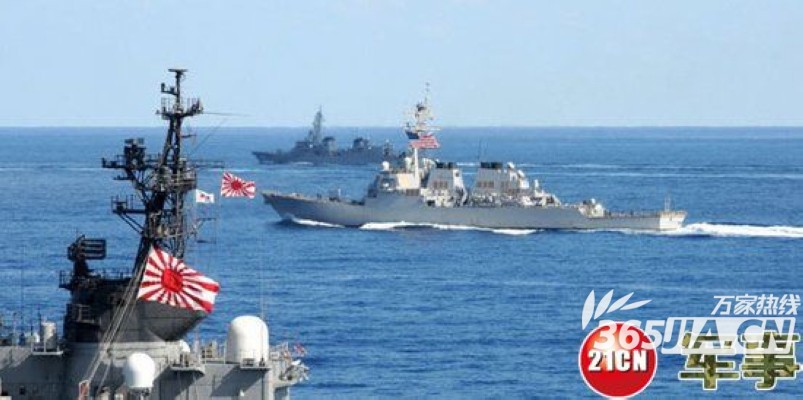By Kyle Mizokami

Are the United States and China set on a collision course that ends in war?
White House advisor Stephen Bannon thinks so.
Both countries are preparing for the worst case scenario.
War on the Rocks has an intriguing set of satellite images that indicate that preparations on the Chinese side are farther along—and more specific—that anyone previously believed.
The United States maintains an extensive network of bases in the Asia-Pacific region.
The United States maintains an extensive network of bases in the Asia-Pacific region.
Much of the network is a holdover from World War II, preserved through the Cold War, and still in place today.
Naval bases such as Yokosuka and Sasebo, and air bases such as Yokota, Kadena, and Osan protect America's allies while projecting American power into the region.
Some of America's most advanced military equipment, from F-22 Raptors to B-1 Lancer and B-2 Spirit bombers to a full carrier battle group are deployed in an arc stretching from South Korea to Guam.
China sees those bases as a threat—and it's not necessarily wrong.
China sees those bases as a threat—and it's not necessarily wrong.
The great distances between the continental United States and China mean the U.S. military will need those bases to prosecute any war between the two countries.
According to WotR, China is actively practicing hitting those bases with long-range ballistic and cruise missiles.
For decades, China's main means of power projection was in the form of ballistic missiles, and large numbers of them.
For decades, China's main means of power projection was in the form of ballistic missiles, and large numbers of them.
Ballistic missiles—placed under the command of what is now the People's Liberation Army-Rocket Forces—are an inexpensive and efficient way of delivering warheads long distances.
They're cheaper than aircraft carriers, or long-range bombers, but can still pack a considerable punch. Modern guidance systems, even those not using GPS, can target with precision.

The DF-21D intermediate-range ballistic missile, for example, can hit moving aircraft carriers at sea.
Japan's attack on Pearl Harbor, the preemptive strike that brought the United States into World War 2, was a tactical success but a strategic failure.
Japan's attack on Pearl Harbor, the preemptive strike that brought the United States into World War 2, was a tactical success but a strategic failure.
Although Japan managed to sink several battleships, it failed to destroy the what really mattered—the port facilities, fuel storage depots, and other critical infrastructure that sustained American air and naval power.
Ships and planes eventually need fuel and maintenance.
Without those facilities, the U.S. Navy could not have sustained the counterattack that led to the Battle of Midway, and might have even been forced to withdraw thousands of miles eastward to the West Coast.


Satellite imagery shows China is preparing to target ships in port, particularly at Yokosuka naval base, and individual hardened aircraft bunkers at Kadena Air Force Base on the island of Okinawa.
What's more, China appears to have learned Japan's lesson: it's also practicing targeting electrical substations, above-ground fuel storage depots, and other support facilities.
The goal would be to force American forces back to Guam or even Hawaii, isolating America from allies Japan, Australia, and even South Korea.
The attack plan appears comprehensive and well thought-out.
The attack plan appears comprehensive and well thought-out.
The satellite imagery shows that cluster munition strikes have been carried out against simulated Patriot PAC-2 and PAC-3 missile batteries, the primary American defense against Chinese missile strikes.

A mobile, land-based air defense missile capable of shooting down aircraft, cruise missiles, and ballistic missiles, Patriot is particularly vulnerable to attack by ballistic missiles that dump cluster munitions over a wide area.
The imagery should serve as a reminder that the Chinese are maximizing their resources and are prepared to take on the might of the U.S. military.
The Pentagon should be prepared for a tough fight.
| World War III Casualties | ||||
| 2016 Population | Killed | Survivors | ||
| CHINA | 1 373 541 278 | 1 057 119 689 | 77% | 316 421 589 |
| UNITED STATES | 323 995 528 | 19 089 783 | 6% | 304 905 745 |
| EUROPEAN UNION | 513 949 445 | 371 356 958 | 72% | 142 592 487 |
| RUSSIA | 142 355 415 | 30 924 816 | 22% | 111 430 599 |
| INDIA | 1 266 883 598 | 1 158 499 174 | 91% | 108 384 424 |
| PAKISTAN | 201 995 540 | 175 747 473 | 87% | 26 248 067 |
| JAPAN | 126 702 133 | 114 241 889 | 90% | 12 460 244 |
| VIETNAM | 95 261 021 | 84 340 688 | 89% | 10 920 333 |
| PHILIPPINES | 102 624 209 | 92 732 902 | 90% | 9 891 307 |
| KOREA, NORTH | 25 115 311 | 21 141 050 | 84% | 3 974 261 |
| KOREA, SOUTH | 50 924 172 | 47 636 302 | 94% | 3 287 870 |
| TAIWAN | 23 464 787 | 22 278 490 | 95% | 1 186 297 |
| 4 246 812 437 | 3 195 109 214 | 75% | 1 051 703 223 | |

Aucun commentaire:
Enregistrer un commentaire